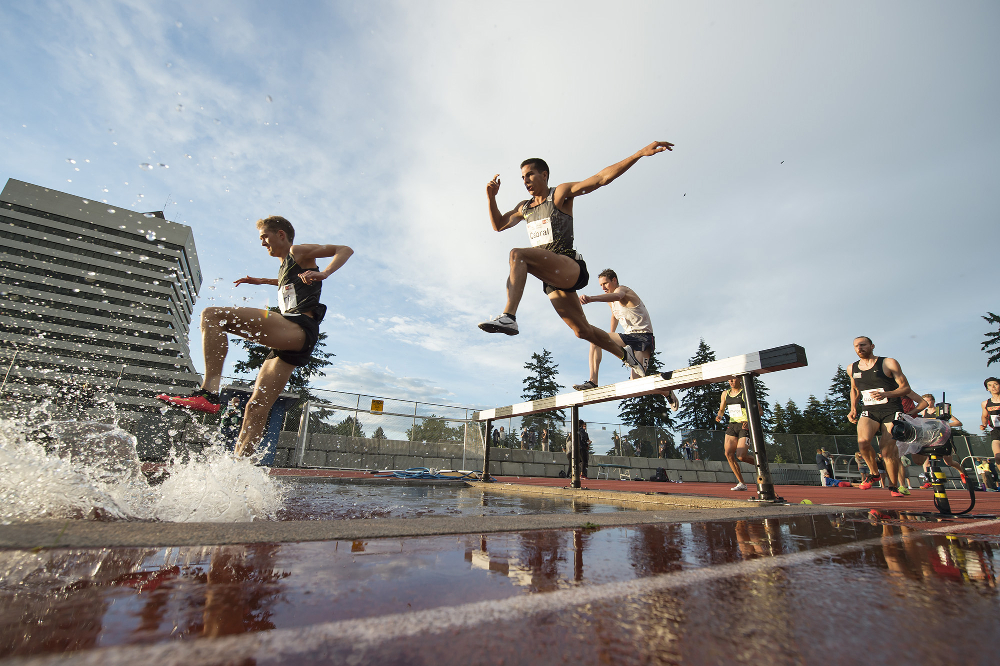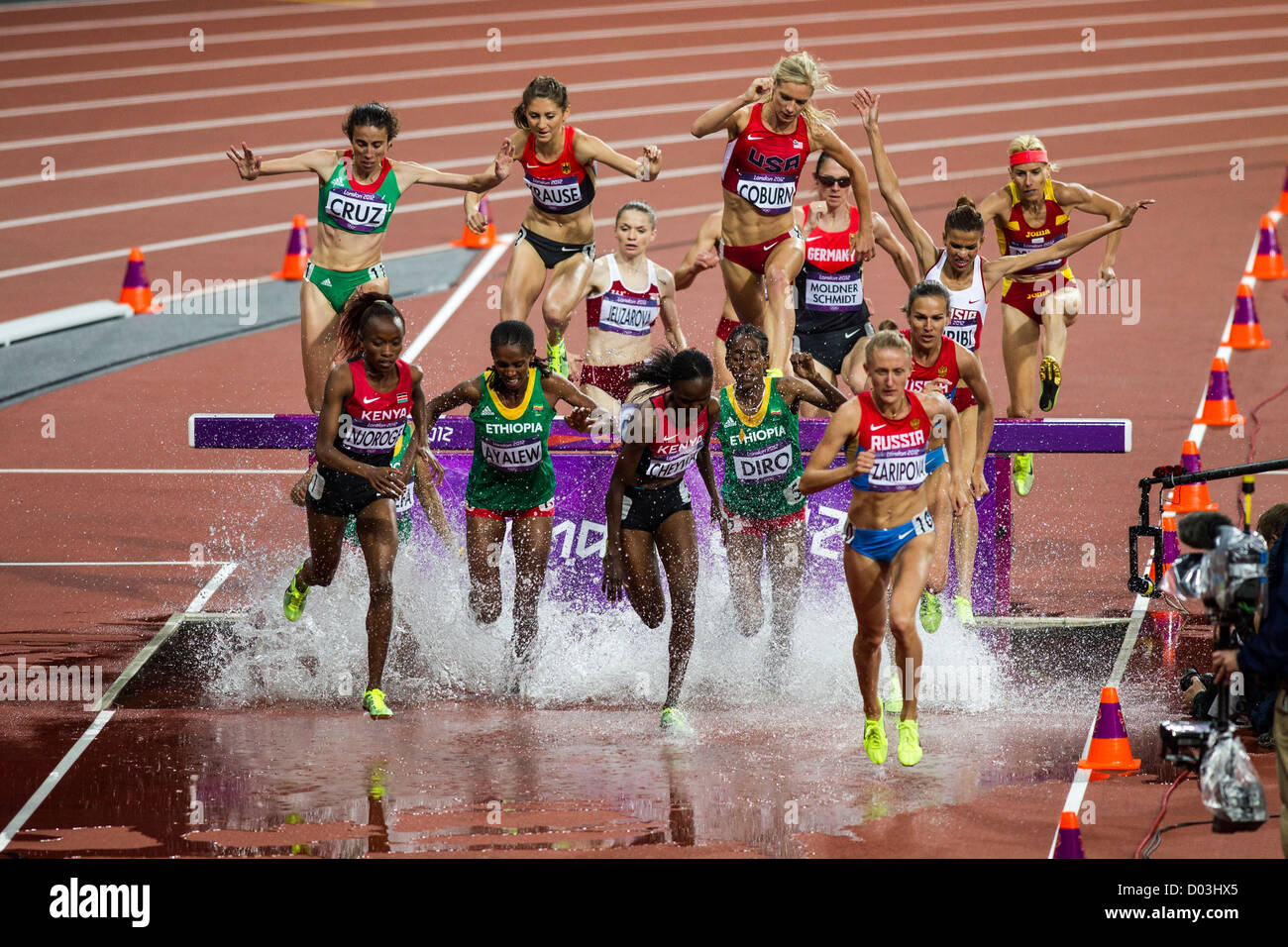History and Evolution of the 3000m Steeplechase: 3000m Steeplechase Olympics

The 3000m steeplechase, a demanding and captivating event in track and field, has a rich history that intertwines with the evolution of the sport itself. Its origins can be traced back to the early days of cross-country running, where obstacles were often encountered on natural courses. The modern steeplechase, however, emerged as a distinct event with its own unique set of rules and challenges.
The development of the 3000m steeplechase as an Olympic event has been marked by significant changes in regulations and notable performances. From its early days to the present, the event has undergone a transformation, reflecting the ongoing pursuit of excellence and innovation in athletics.
Origins and Development of the 3000m Steeplechase
The origins of the steeplechase can be traced back to the early days of cross-country running, where runners would encounter natural obstacles such as streams, fences, and ditches. The term “steeplechase” itself is believed to have originated from a race in Ireland, where runners had to jump over a series of obstacles, including a church steeple.
The first official steeplechase race was held in 1860 at the Sandown Park Racecourse in England. The race was run over a distance of four miles and included a series of hurdles and water jumps. The steeplechase quickly gained popularity, and by the late 19th century, it had become a regular fixture in athletics competitions around the world.
The 3000m steeplechase, as we know it today, was first included in the Olympic Games in 1920 at the Antwerp Games. The event was initially run over a distance of 3000 meters, with 28 hurdles and seven water jumps. The rules and regulations of the event have evolved over time, with the number of hurdles and water jumps being adjusted, and the height of the hurdles being standardized.
Rules and Regulations of the 3000m Steeplechase
The rules and regulations of the 3000m steeplechase have undergone several changes throughout its history. Here are some of the key changes that have shaped the event:
- The number of hurdles and water jumps has been adjusted over time. Initially, the event featured 28 hurdles and seven water jumps. This was later reduced to 35 hurdles and seven water jumps, and then further reduced to the current 28 hurdles and seven water jumps.
- The height of the hurdles has been standardized. The height of the hurdles was initially 91.4 cm (36 inches), but was later lowered to 91.4 cm (36 inches) for men and 76.2 cm (30 inches) for women.
- The water jumps have been modified to improve safety. The water jumps were initially quite deep, but they have been gradually shallowed over time to reduce the risk of injury.
- The method of clearing the water jump has been standardized. Runners are required to clear the water jump by jumping over it, and they are not allowed to swim or wade through it.
Notable Moments and Records in the Steeplechase at the Olympics
The 3000m steeplechase has produced some of the most memorable moments in Olympic history. Here are some of the notable moments and records set in the event at the Olympics:
- In 1920, the first Olympic steeplechase race was won by Percy Hodge of Great Britain, who set a new Olympic record of 10:57.2.
- In 1952, the first sub-9-minute steeplechase race was run by Horace Ashenfelter of the United States, who set a new world record of 8:51.2.
- In 1964, Henry Rono of Kenya set a new world record of 8:05.4, which stood for 13 years.
- In 1984, Julius Korir of Kenya became the first man to break the 8-minute barrier, setting a new world record of 7:59.06.
- In 2004, Saif Saaeed Shaheen of Qatar became the first man to run a sub-7:55 steeplechase, setting a new world record of 7:53.63.
- In 2012, Ezekiel Kemboi of Kenya became the first man to win the 3000m steeplechase at the Olympics three times.
Technical Aspects and Strategies

The 3000m steeplechase is a grueling event that requires a unique blend of endurance, speed, and technical proficiency. Elite steeplechase runners employ specific techniques and strategies to optimize their performance and navigate the challenging course.
Pacing
Pacing is crucial for success in the steeplechase. Runners must carefully manage their energy expenditure throughout the race to avoid burning out too early.
- A common strategy is to start at a moderate pace, gradually increasing speed over the middle laps, and then pushing hard in the final lap.
- The optimal pacing strategy depends on the runner’s strengths and the race situation. Some runners may prefer to run a more even pace, while others may opt for a more aggressive approach.
Water Jump Clearance
The water jump is a signature obstacle in the steeplechase.
- Runners typically approach the water jump at a high speed and use a powerful leap to clear the barrier.
- The key is to maintain momentum and land softly on the other side to minimize energy loss.
- Experienced steeplechasers often develop their own unique techniques for clearing the water jump, but a common approach involves a strong push-off with the lead leg, followed by a powerful swing of the trailing leg to propel the runner over the barrier.
Obstacle Negotiation, 3000m steeplechase olympics
The steeplechase course features a series of hurdles that must be negotiated efficiently.
- Runners typically use a three-step approach to clear the hurdles, similar to other track and field events.
- The key is to maintain speed and rhythm while clearing the obstacles, minimizing any loss of momentum.
- Steeplechasers must also be mindful of the water jump, which is often placed near the hurdles, requiring them to adapt their approach to avoid a potential fall.
Training Methods
Steeplechase athletes employ a variety of training methods to develop the necessary physical and mental attributes.
- Training typically involves a combination of endurance runs, speed workouts, and obstacle drills.
- Endurance runs help build aerobic capacity and stamina, while speed workouts improve acceleration and top-end speed.
- Obstacle drills focus on refining the technique for clearing the hurdles and water jump.
Notable Athletes and Performances

The 3000m steeplechase has witnessed numerous legendary athletes who have pushed the boundaries of human endurance and left an indelible mark on the sport. Their achievements have not only shaped the history of the event but also inspired generations of athletes.
The following section explores some of the most successful and influential steeplechase athletes in Olympic history, providing detailed analysis of their performances, including key races and records. It also discusses the impact of their achievements on the sport and its evolution.
Notable Steeplechase Athletes
These athletes have left a lasting legacy on the sport.
- Saïd Aouita (Morocco): Aouita’s dominant performances in the 1980s revolutionized the 3000m steeplechase. He broke the world record twice, first in 1984 with a time of 8:05.12 and then again in 1987 with a time of 7:53.63. He also won the Olympic gold medal in 1984, establishing himself as one of the greatest steeplechasers of all time.
- Julius Kariuki (Kenya): Kariuki was a dominant force in the 1990s, winning the 1992 Olympic gold medal and the 1993 World Championship. He also held the world record for a period, setting a time of 7:55.28 in 1993. His performances helped to elevate the sport to new heights, particularly among Kenyan athletes.
- Ezekiel Kemboi (Kenya): Kemboi is widely considered one of the most successful steeplechasers of all time. He won four Olympic medals, including two gold medals (2004 and 2012), and three World Championship gold medals. Kemboi was known for his powerful kick in the final lap, often leaving his opponents trailing behind. His consistent success cemented Kenya’s dominance in the event.
- Conny Sodergren (Sweden): Sodergren was a pioneer of the steeplechase, setting a new world record in 1975 with a time of 8:14.40. He also won the 1976 Olympic bronze medal. His achievements helped to popularize the event in Europe and beyond.
- Wilson Kipketer (Kenya): While primarily known for his 800m success, Kipketer also competed in the steeplechase and set a world record in 1997 with a time of 7:59.08. He won the 1997 World Championship gold medal in the event, showcasing his versatility and talent.
Key Races and Records
These athletes have produced some of the most memorable races in steeplechase history.
- 1984 Los Angeles Olympics: In the 1984 Olympics, Saïd Aouita set a new world record of 8:05.12 to win the gold medal, leaving his competitors in awe. This race cemented his status as a legend of the event.
- 1992 Barcelona Olympics: Julius Kariuki won the 1992 Olympic gold medal with a time of 8:08.99, showcasing his dominance in the event.
- 2004 Athens Olympics: Ezekiel Kemboi won the 2004 Olympic gold medal with a time of 8:05.81, using his powerful kick in the final lap to overcome his opponents.
- 2012 London Olympics: Kemboi defended his Olympic title in 2012, winning the gold medal with a time of 8:18.56. This victory solidified his legacy as one of the greatest steeplechasers of all time.
Impact on the Sport
The achievements of these athletes have had a profound impact on the sport of steeplechase.
- Increased Popularity: Their performances have helped to increase the popularity of the event, attracting a wider audience and inspiring new generations of athletes.
- Technological Advancements: The pursuit of records has led to technological advancements in footwear and training techniques, improving performance and pushing the boundaries of human endurance.
- Global Dominance of Kenyan Athletes: The success of Kenyan athletes like Julius Kariuki and Ezekiel Kemboi has cemented Kenya’s dominance in the event. Their achievements have inspired a new generation of Kenyan steeplechasers, ensuring the country’s continued success in the years to come.
3000m steeplechase olympics – The 3000m steeplechase is a brutal test of endurance and agility, and the Olympics is where the world’s best athletes come to compete. Lamecha Girma, the rising star of the event, has been making headlines recently, but not for his speed on the track.
You can read all about his current injury status and what’s next for the young athlete in this lamecha girma injury update. His absence will be felt at the next Olympics, but the competition remains fierce, with athletes vying for the chance to etch their name in the history books of this grueling event.
The 3000m steeplechase is a thrilling event at the Olympics, a test of endurance and agility. It’s not just about speed, but also about conquering the water jumps and hurdles, which can sometimes lead to unexpected stumbles. If you’re interested in understanding the reasons behind these falls and how to prevent them, check out this article on men’s steeplechase falls , which offers insights into the challenges athletes face.
Ultimately, it’s the resilience and skill of these athletes that make the 3000m steeplechase a truly captivating spectacle.